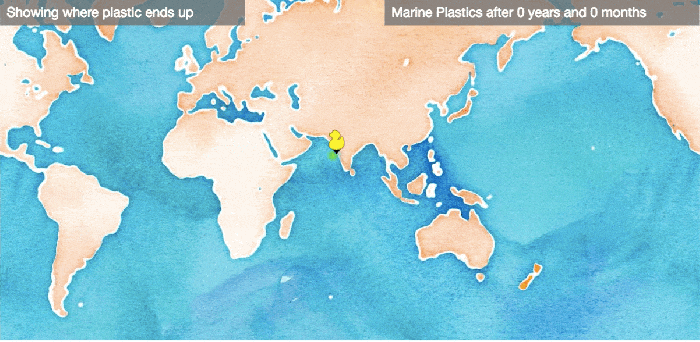Modelling shows that ocean currents can concentrate slow-degrading debris in certain parts of the world’s oceans, leading to so-called ‘garbage patches’.

It is estimated that between four and 12m metric tonnes of plastic makes its way into the ocean each year. This figure is only likely to rise, and a 2016 report predicted that by 2050 the amount of plastic in the sea will outweigh the amount of fish.
. . . A lot of plastic debris in the ocean breaks down into smaller pieces and is ingested by marine life, and it is thought that a significant amount sinks to the sea bed. But a lot of it just floats around, and thanks to sophisticated modelling of ocean currents using drifting buoys, we can see where much of it ends up.
Oceanographer Erik van Sebille, who works at Imperial College London and Utrecht University in the Netherlands, has shown that thanks to strong ocean currents known as gyres, huge amounts of plastic end up in “garbage patches” around the world, the largest one being in the north Pacific.
As can be seen in the image above, a bottle dropped in the water off the coast of China, near Shanghai, is likely be carried eastward by the north Pacific gyre and end up circulating a few hundred miles off the coast of the US.
A bottle dropped off the Mexican coast, near Acapulco, is likely to be caught in the same gyre. Some of the plastic waste drifts south, but a huge amount is swept west towards Asia before floating north and ending up in the same area – the so-called Great Pacific Garbage Patch [aka Pacific Trash Vortex].

The North Atlantic is home to another powerful current. The image below shows what happens to plastic debris that enters the ocean around New York. Initially a lot of it heads over to Europe, with concentration in the Bay of Biscay and, to a lesser extent, the North Sea, but the majority is trapped by the current and ends up floating in the middle of the ocean.

It’s a similar story in the UK. A bottle dropped in the sea off Cornwall may well be dragged through the channel towards Scandinavia, but the greatest concentrations are again in the Bay of Biscay and the western North Atlantic.

India is one of the world’s biggest plastic polluters, creating more than 15,000 tonnes of plastic waste a day. The plastic waste that enters the water around Mumbai is likely to end up either being caught in the Indian Ocean gyre and floating close to Madagascar, or being swept east and into the Bay of Bengal, one of the worst places in the world for plastic pollution

You can explore further modelling on Van Sebille’s website, Plastic Adrift.
By Alan Evans, The Guardian
June 29, 2017
